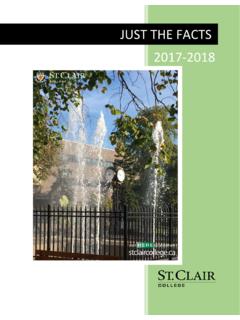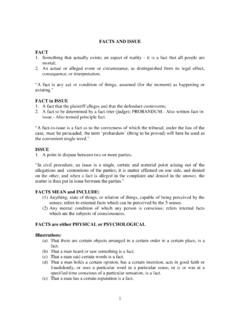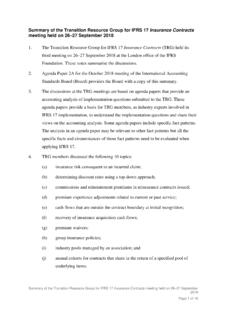Transcription of FATALFacts - Occupational Safety and Health …
1 BRIEF DESCRIPTION OF INCIDENTT hree workers were adding tower sections to increase the height of a material hoist when it collapsed (see Figure 1). The material hoist was acquired from a rental company s yard, where it had sat idle for about a year. One of the workers operated the motor for the carriage. Two of the workers gained access to the material hoist to install the tower sections by riding on top of the hoist s carriage or car. They wore body harnesses and their lanyards were connected to the gin pole1 of the material hoist. When they stopped at the top of the ninth tower section to install an additional section, one of the workers disconnected his lanyard from the gin pole and connected it to a lifeline which was hanging from the roof edge and anchored to a steel beam. The other worker s lanyard remained connected to the gin pole.
2 They felt a drop in the carriage assembly, but continued working. The Safety chain (see Figure 2) connecting the carriage to the tower broke and the Safety brakes ( , safeties, dog brakes , car arresting device) did not activate to stop the carriage from falling. The carriage fell 90 feet to the ground, the gin pole broke and the worker who had his lanyard connected to the gin pole fell to his death. Likely Causes of Incident Workers were improperly trained on how to erect the material hoist and use fall protection. OSHA s incident investigation revealed that the material hoist s Safety brake system was improperly installed; therefore, it could not work. It was also not inspected and tested before use, after not being used for about a year. The manufacturer s recommendations for erecting the tower were not followed: The Safety chain was wrapped around the tower leg (see Figure 2) each time the carriage was stopped to place a tower section.
3 In addition, the Safety chain was not welded together at the eye bolt connection to the hoist as specified by the manufacturer. Workers were allowed to connect their fall protection systems to the gin pole of the hoist. Workers were permitted to ride on top of the hoist s SUMMARYI ncident type: .. material hoist collapseWeather conditions/Time of day: ..Partly sunny/approx. 1:00 PMType of operation: ..Scaffolding and material hoist erectionSize of work crew: ..3 Worksite inspection conducted: ..YesCompetent Safety monitoring on site: ..YesSafety and Health program in effect: ..YesTraining and education for workers: ..InadequateOccupation of deceased worker ..Carpenter/ErectorAge/Sex of deceased worker ..37/MTime on job: ..Not AvailableTime at task: ..Approximately 4-5 hoursTime employed/classification (FT/PT/Temporary).
4 Full timeLanguage spoken: ..EnglishUnion/Non-Union: ..Non-UnionFigure 1: material hoist collapseFATALF acts8 No. 8 2014 material Hoist Department of Labor Occupational Safety and Health Administration (800) 321-OSHA (6742)TowerBaseCollapsed carriage or carAdjacent buildingFigure 2: The Safety chain was wrapped around the tower leg instead of being connected to the bolt plate of the material 3: material hoistTowerBaseCarriage or carDTSEM FF-3718 3/2014 INCIDENT PREVENTIONTo prevent similar incidents from occurring employers must: Train workers on the proper procedures for erecting, inspecting, testing and maintaining the material hoist as recommended by the manufacturer (29 CFR (b)(2)). Workers must also be trained on how to recognize fall hazards and protect themselves from those hazards (29 CFR (a)).
5 Performing regular maintenance, inspection and testing of all functions and Safety devices ( , Safety brake system (29 CFR (b)(6)), Safety chain, hoist cable) of the hoist, supervised by a competent person, before putting the hoist in service, after major alterations, and at not more than 3-month intervals, will help to ensure that the hoist functions properly. Comply with the manufacturer s specifications (29 CFR (a)(1)). For example: Install the Safety chain as specified by the manufacturer. Comply with the welding method required by the manufacturer of the Safety chain to ensure that it is correctly attached. Ensure that workers personal fall arrest systems (PFASs)2 are not connected to any part of the material hoist (see Figure 3) when working outside it to install tower sections. Connect workers PFASs to an independent anchorage.
6 For example, an adjacent building s steel beam that is not used to support or suspend the carriage and is capable of supporting at least 5,000 pounds for each worker attached ( (d)(15)). An anchorage designed, installed and used under the supervision of a qualified person and as part of a complete PFAS capable of supporting at least twice the weight expected to be imposed upon it can be used instead. Lifelines must be protected from cuts or abrasions (29 CFR (d)(11)) at all times. Prohibit workers from riding on top of a material hoist s carriage. Also, workers must not ride inside a material hoist s carriage except during inspection and maintenance activities (29 CFR (b)(1)(ii)). However, an OSHA Letter of Interpretation (dated April 7, 1987) states that workers can ride inside a material hoist s carriage when erecting towers, only if there is no other way to access the material hoist.
7 Otherwise, when adding tower sections, workers should access a material hoist by using the stairways and windows of the adjacent building that the material hoist is anchored : The described case was selected as being representative of improper work practices which likely contributed to a fatality from an incident. The incident prevention recommendations do not necessarily reflect the outcome of any legal aspects of this case. OSHA encourages your company or organization to duplicate and share this Fatal Facts is not an OSHA standard or regulation and it creates no new legal obligations. The recommendations contained herein are advisory in nature and are intended to assist employers in providing safe and healthful workplaces. The Occupational Safety and Health Act of 1970 (OSH Act) requires employers to comply with Safety and Health standards promulgated by OSHA or by an OSHA-approved state plan.
8 The requirements of OSHA-approved state plans can be reviewed by selecting the state s web site at: The OSH Act s General Duty Clause, Section 5(a)(1), requires employers to provide employees with a workplace free from recognized hazards likely to cause death or serious physical Have a Voice in the WorkplaceThe Occupational Safety and Health Act of 1970 affords workers the right to a safe workplace (see OSHA s Worker Rights page, ). Workers also have the right to file a complaint with OSHA if they believe that there are either violations of OSHA standards or serious workplace hazards. How OSHA Can HelpFor questions or to get information or advice, to report an emergency, report a fatality or catastrophe, or to file a confidential complaint, contact your nearest OSHA office, visit or call our toll-free number at 1-800-321-OSHA (6742), TTY 1-877-889-5627.
9 It s InformationOSHA standards and regulations: publications: state plans adopt and enforce standards which may differ from Federal regulations: s free On-site Consultation services: resources: Assistance services: of terms as used in this document1 A gin pole is a device used to lift tower sections during assembly and disassembly of the material A PFAS is used to arrest (stop) a worker in a fall from a working level. It consists of an anchorage, connectors, a body harness and may include a lanyard, deceleration device, lifeline or suitable combinations of these.














